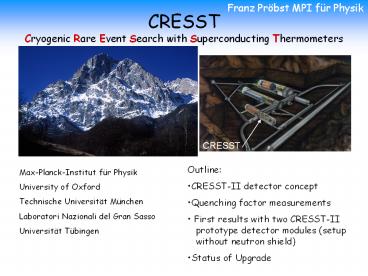CRESST Cryogenic Rare Event Search with Superconducting Thermometers - PowerPoint PPT Presentation
Title: CRESST Cryogenic Rare Event Search with Superconducting Thermometers
1
CRESST Cryogenic Rare Event Search with
Superconducting Thermometers
Franz Pröbst MPI für Physik
CRESST
- Outline
- CRESST-II detector concept
- Quenching factor measurements
- First results with two CRESST-II
prototype detector modules (setup without
neutron shield) - Status of Upgrade
Max-Planck-Institut für Physik University of
Oxford Technische Universität München Laboratori
Nazionali del Gran Sasso Universität Tübingen
2
CRESST-II Detector Concept
Discrimination of nuclear recoils from
radioactive ?? backgrounds (electron recoils) by
simultaneous measurement of phonons and
scintillation light
proof of principle
Separate calorimeter as light detector
W-thermometer
Energy in light channel keVee
300 g scintillatingCaWO4 crystal
W-thermometer
Energy in phonon channel keV
light reflector
3
300 g Prototype Detector Module
CRESST-II 33 detector modules ? 66 readout
channels
4
Recoil energy spectrum in CaWO4 expected from
neutrons at Gran Sasso (no neutron shield)
Monte Carlo simulation dry concrete
Contribution of W recoils negligible above 12 keV
? ? A2 for WIMPs with spin independent interaction
WIMPs dominantly scatter on W (A184) nuclei
5
Quenching factor measurement with TOF
Ion source
PTFE reflector
Deflection plate for ion type selection
W, O, Ca ions
PMT
UV Laser
collimator
CaWO4 crystal
target
- UV Laser desorbs singly or doubly charged ions
from almost any material. Acceleration to 18 keV
(or 32 keV for double charged) - Mount CaWO4 crystal on PMT at end of flight tube
and count single photons after arrival of ion. - Adjust laser intensity such that more than 1 ion
arriving per laser shot is negligible.
6
Single photon counting after arrival of ion
7
Quenching factor measurement with TOF
Light curve of scintillator
Photon counts per laser shot
Comparision with photon counts per 6 keV x-ray
yields quenching factor
8
Quenching Factors for various nuclei in CaWO4
High value of Q40 for tungsten ? very little
light for recoils lt40 keV
at 300 K
at 7 mK
Discriminate W recoils (WIMPS) from O/Ca recoils
of neutrons
9
Data taken with two 300 g prototype modules
Energy resolution of phonon channel
Pulse height of heater pulses
(3.2 0.5) counts/day
1.0 keV FWHM
? 1.0 keV _at_ 46.5 keV ? 6.7 keV _at_ 2.3 MeV
Very stable response over a period of 40 days
10
Low Energy Event Distributionno neutron shield
90 of nuclear recoils with quenching factor
expected for neutron induced recoils below this
line.Rate0.87?0.22 /kg/day compatible with
expec-ted neutron rate.
10.72 kg days
90 of nuclear recoils with quenching factor 40
(W) below this line.
No events in 12 to 40 keV range
11
Upper limit for spin indepentend WIMP nucleon
cross section
6.17 kg days W exposure
12
Stability of exlusion limit
Variation of threshold
Variation of quenching factor
Including the 2 events at 10.5 and 11.2 keV has
practically no effect on result.
Variation of Q well beyond uncertainties has only
small effect?1.6x10-6 ? 2.3x10-6 pb
13
Detector Performance at high Energies
- Excellent linearity and energy resolution at
high energies - Perfect discrimination of ?? from ?s
- Identification of alpha emitters
? and ?
? peaks
14
232Th calibration Linearity of detector response
at high energies
15
Identification of ?-Emitters
- Same light for extern and intern 210Po ? no
surface degradation - Relatively low alpha rates total 2mBq/kg.238U
2 10-12g/g
??
16
147Sm
17
Half-life for the a-decay of 180W
exposure 28.62 kg days
Half life T1/2 (1.80.2) x 1018 years
Energy Q (2516.41.1 (stat.)1.2(sys.)) keV
Phys. Rev. C 70 (2004) 64606
18
Status of Upgrade
- Read out and electronics66 SQUIDs for 33
detector modules (10 kg target) and DAQ ready - Neutron shield 50 cm polyethylen (installation
complete) - Muon veto 20 plastic scintillator pannels
outside Cu/Pb shield and radon box. Analog fiber
transmission through Faraday cage (ready) - Detector integration in cold box and wiring
(entering fabrication stage)
19
Detector integration in existing cold box
- Mounting of 33 detector modules at end of
cold finger - Detectors indivi-dually exchangeable
- Spring suspension for vibration decoupling from
cryostat.
20
Conclusion
- Two CRESST II prototype detectors have been
operated for two months. - Discrimination threshold (???) well below 10 keV
- Type of recoiling nucleus identified above 12
keV - Upgrade to 66 readout channels (10 kg target),
installation ofneutron shield and muon veto
almost complete. Restart in
summer/autumn 2005 - CRESST-II is aiming for a sensitvity of ?10-8 pb































